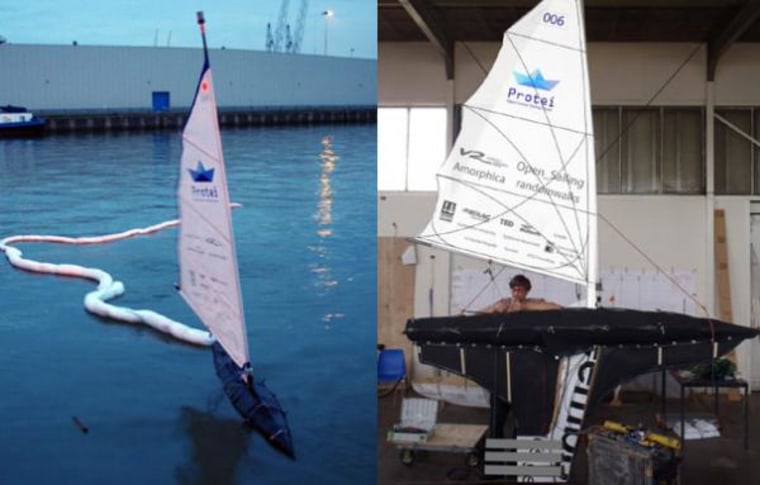Sail technology drove exploration of the seas and helped build worldwide empires for centuries, but began falling out of favor with the rise of steamships in the 1800s. Now an open-source project wants to once again harness the winds to deploy a fleet of robotic sailing vessels across the world's oceans within the next decade.
The idea came to Cesar Harada as he watched human attempts to skim off the massive oil spill after the Deepwater Horizon disaster in the Gulf of Mexico. He envisioned a robotic ship capable of wriggling its flexible body like a worm through the oil slick, all while dragging a long tail of absorbent material to soak up the spilled oil.
Swarms of sailing drones could also clean up ocean garbage patches, monitor pollutants and keep an eye on endangered marine life. To make the dream a reality, Harada coordinates the Protei project that launched its sixth prototype — produced by the V2_ Institute for the Unstable Media — during World Port Day in Rotterdam, the Netherlands, on Sept. 2.
"Collecting oil is the most difficult of all," said Piem Wirtz, project manager of the V2_ Institute for the Unstable Media in Rotterdam. "If we succeed in cleaning up oil using sailing power, an articulated hull, and drag a heavy absorbing load, we can do pretty much anything."
The early prototypes represent simple, remote-controlled watercraft meant to show how well a sailing drone could work. The flexible, sectioned body design allows it to tack back and forth more efficiently as it sails against the wind — and sailing upwind would allow the robotic ship to tackle oil slicks moving downwind.
Most existing sea drones resemble submarines or torpedoes that travel underwater and avoid the turbulent forces at the ocean's surface. Creating a surface vessel forced the team led by Harada and Wirtz to test how a sailing drone could survive violent waves and winds by laying its sail flat on the water.
"Sailing drones are much more difficult to engineer, since they operate on the water surface," Wirtz told InnovationNewsDaily. "At the surface (where spilled oil floats), a drone has to face the waves, the wind, the currents, the water."
The Protei project has survived so far on private donations through crowd-sourced websites such as Kickstarter, even as building costs for each version of the sailing drone have grown from a few hundred dollars to $10,000. But the team has begun talking with several companies about joining the "Open Hardware" effort — all of their designs and test information are published online.
Eventually, the team wants to make Protei drones more capable of operating without human help. That means moving from a remote-controlled version running on batteries to a swarm of drones that rely solely upon sun and wind power, make their own decisions, can cooperate in groups and can also work with humans.
"This should be doable within a decade," Wirtz said.
You can follow InnovationNewsDaily Senior Writer Jeremy Hsu on Twitter @ScienceHsu. Follow InnovationNewsDaily on Twitter @News_Innovation, or on Facebook.
